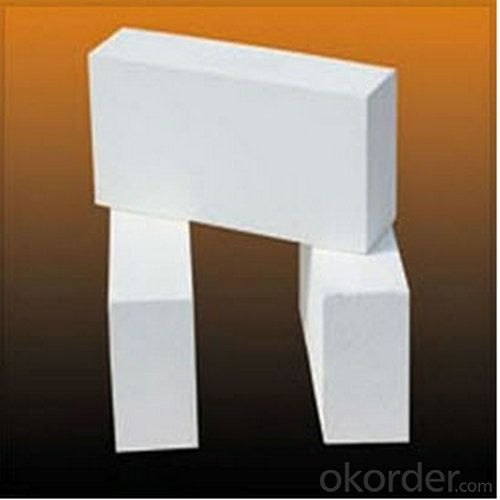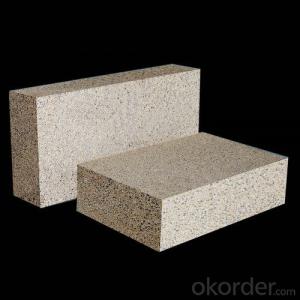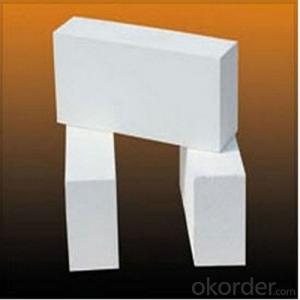Insulating Firebricks Manufactured from High Purity Alumina Clay
- Loading Port:
- Tianjin
- Payment Terms:
- TT OR LC
- Min Order Qty:
- 1 m.t.
- Supply Capability:
- 20000 m.t./month
OKorder Service Pledge
OKorder Financial Service
You Might Also Like
Description of Insulating Firebricks
CMAX Insulating Firebricks are classified under temperature between 1300℃ to 1700℃, manufactured from high purity alumina clay.
Features of Insulating Firebricks
Light weight and low thermal conductivity
Low heat storage
Low iron and impurities
High thermal shock resistance
Applications of Insulating Firebricks
CMAX Insulating Firebricks can be used as a hot face lining directly exposed to the heat or as a backup insulation layer in iron and steel mills, non-ferrous foundries, petrochemical, ceramic, glass.
Specifications of Insulating Firebricks
°C Classification Temperature °F | 1260 2300 | 1350 2500 | 1430 2600 | 1540 2600 | 1650 3000 | 1760 3200 | |
ASTM C134-95 g/cm³ Bulk Density ib/ft³ | 0.60 37 | 0.80 50 | 0.80 50 | 0.90 56 | 1.03 64 | 1.25 78 | |
ASTM C133-97 Mpa Cold Crushing Strength ib/in² | 1.2 170 | 2.0 284 | 2.0 284 | 2.6 370 | 2.8 398 | 3.4 484 | |
ASTM C133-97 Mpa Modulus of rupture ib/in² | 0.9 128 | 1.2 170 | 1.5 218 | 1.6 232 | 1.7 247 | 2.0 290 | |
ASTM C210-95 % Permanent Liner Change °C*hrs | 0 1230*24 | -0.5 1350*24 | -0.5 1400*24 | -0.8 1510*24 | -0.9 1620*24 | -0.9 1730*24 | |
ASTM C182-88 Thermal Conductivity (W/m.k) | 400°C | 0.17 | 0.24 | 0.24 | 0.30 | 0.40 | 0.49 |
600°C | 0.19 | 0.28 | 0.27 | 0.32 | 0.42 | 0.50 | |
800°C | 0.22 | 0.32 | 0.30 | 0.35 | 0.44 | 0.51 | |
1000°C | 0.25 | 0.37 | 0.32 | 0.38 | 0.45 | 0.53 | |
1200°C | --- | --- | 0.35 | 0.39 | 0.47 | 0.55 | |
Chemical Analysis of Insulating Firebricks | |||||||
Al2O3 % | 45 | 50 | 55 | 65 | 72 | 76 | |
Fe2O3 % | 0.9 | 0.8 | 0.8 | 0.5 | 0.4 | 0.3 | |
SiO2 % | 50 | 45 | 42 | 32 | 26 | 22 | |
CaO+MgO % | 0.7 | 0.6 | 0.3 | 0.2 | 0.3 | 0.2 | |
K2O+Na2O % | 1.3 | 1.0 | 1.0 | 0.8 | 0.2 | 0.1 | |
Images of Insulating Firebricks


FAQ of Insulating Firebricks
1. Which products do you have?
We have all kinds of refractory brick, castable, mortar, cement, ceramic fiber products, etc.
Or you could browse our products to choose what you need.
2. Can you give me a general idea of the specification and technical data of your products?
CNBM offer a range of refractory and insulation products. We provide refractory bricks, monolithic refractories as well as ceramic fiber products. And On your given shapes, drawings or description, we are producing refractories with all sizes and shapes, resistant to temperature from 800 °C till 1800 °C, using various machines and equipments for cutting, grinding, drilling, polishing, shaping processes.
Every refractory product by CNBM is of superior quality. Lesser refractory products can not approach. CNBM utilizes proprietary testing methods, testing for chemical content, density, apparent porosity, cold crush strength and modulus of rapture. With stringent quality control, you can count on CNBM products to exceed refractory industry standards and your expectations.
3. Can you give me a brief introduction of the application of your products?
We are mainly specializing in the refractory materials in iron and steel, cement, glass, ceramics, petrochemical, electric power Industry, etc.
4. If I need your offer, what information do you need?
In order to choose suitable products, it will be appreciated to provide us the information, such us specification, technical data, order quantity, products application etc.
If any question, please contact us freely.
- Q:Can insulating fire bricks be used in sewage treatment plants?
- Indeed, insulating fire bricks can find their application in sewage treatment plants. These bricks are specifically engineered to possess exceptional thermal insulation properties, rendering them suitable for high-temperature scenarios. Within sewage treatment plants, various processes necessitate the utilization of heat, such as anaerobic digestion or sludge incineration. Consequently, insulating fire bricks can be employed to encase the walls, floors, and roofs of incinerators or digesters, thereby facilitating the retention of generated heat and enhancing energy efficiency. Moreover, sewage treatment plants often confront corrosive and abrasive surroundings as a result of the presence of chemicals, acids, and solids within the wastewater. Notably, insulating fire bricks are forged from top-notch refractory materials, boasting resistance against chemical assault and erosion. This characteristic endows them with suitability for lining tanks, pipes, or other equipment that may come into contact with corrosive substances. Furthermore, owing to their lightweight nature, insulating fire bricks prove to be more manageable and straightforward to install in comparison to alternative types of refractory materials. This aspect can be particularly advantageous in sewage treatment plants where the need for frequent maintenance or repairs may arise. All in all, insulating fire bricks stand as a versatile and long-lasting choice for implementation within sewage treatment plants. They offer exceptional thermal insulation, resilience against corrosive environments, and ease of installation.
- Q:What is the cost of insulating fire bricks?
- The price range for insulating fire bricks can differ depending on several factors, including the required quantity, brick quality, and supplier. Typically, these bricks can cost anywhere between $2 and $5 per brick. Nevertheless, the price may increase for specialized bricks with unique attributes like enhanced insulation or greater durability. To guarantee the best value for money, it is advisable to obtain quotes from multiple suppliers and compare prices.
- Q:What is the bulk density of insulating bricks?
- Stoneware porcelain water absorption rate is greater than 0.5% and less than or equal to 3%; fine stoneware bibulous rate is greater than 3% and less than or equal to 6%; brick bibulous rate is greater than 6% and less than or equal to 10%; pottery tile water absorption rate is greater than 10%. The water absorption rate of expression: ceramic brick brick >6% = >10% = >3% = fine stoneware porcelain stoneware or porcelain >0.5%
- Q:Can insulating fire bricks be used as a refractory lining material?
- Yes, insulating fire bricks can be used as a refractory lining material. Insulating fire bricks are designed to have low thermal conductivity, which means they can effectively insulate against heat transfer. This makes them suitable for applications where high temperatures need to be maintained or controlled, such as in kilns, furnaces, and industrial ovens. Refractory lining materials are used to protect the structure of these high-temperature environments from the extreme heat generated inside. They need to be able to withstand the thermal shocks, chemical reactions, and mechanical stresses that occur during operation. Insulating fire bricks offer excellent thermal insulation properties, as well as high temperature resistance, making them an ideal choice for refractory lining applications. In addition to their insulating properties, insulating fire bricks also have low density, making them lightweight and easier to handle and install. This can be beneficial in applications where weight is a concern or where refractory linings need to be replaced or repaired frequently. It is important to note that the specific type and composition of insulating fire bricks may vary, and different applications may require different properties. Therefore, it is essential to consult with a refractory engineer or supplier to ensure the chosen insulating fire bricks are suitable for the specific requirements of the application.
- Q:Can insulating fire bricks be used in chemical processing plants?
- Indeed, chemical processing plants can utilize insulating fire bricks. These bricks are specifically engineered to endure elevated temperatures and offer exceptional thermal insulation. Consequently, they are suitable for a wide range of industrial applications, including chemical processing plants. They can be employed to line furnaces, kilns, reactors, and other apparatuses where high temperatures are involved. The exceptional thermal insulation properties of insulating fire bricks aid in reducing heat loss, enhancing energy efficiency, and maintaining a steady temperature within the processing equipment. Furthermore, these bricks exhibit resistance to chemical corrosion and can withstand the rigorous conditions typically encountered in chemical processing plants. Ultimately, insulating fire bricks serve as a dependable and efficient choice for insulating and safeguarding equipment in chemical processing plants.
- Q:Can insulating fire bricks be used in the construction of pottery molds?
- Insulating fire bricks are indeed applicable for the construction of pottery molds. Crafted from lightweight refractory materials, these bricks possess exceptional heat insulation qualities. Specifically engineered for high-temperature applications like pottery kilns, they offer a range of benefits. When constructing pottery molds, it is imperative to utilize materials that can endure the kiln's intense heat. Insulating fire bricks can withstand temperatures of up to 3000°F (1650°C), rendering them ideal for pottery mold construction. They provide insulation to prevent heat dissipation and maintain consistent temperatures within the kiln, crucial for achieving the desired firing results. Moreover, insulating fire bricks can be conveniently shaped and cut to suit the designated mold design. Their lightweight nature also simplifies handling during the mold construction process. Additionally, the insulating properties of these bricks curtail energy consumption by preventing excessive heat loss, making them a cost-effective choice in the long term. All in all, insulating fire bricks prove to be a fitting option for constructing pottery molds due to their capacity to withstand high temperatures, offer insulation, and be easily molded to meet specific design requirements.
- Q:Are insulating fire bricks suitable for use in kilns and furnaces?
- Yes, insulating fire bricks are suitable for use in kilns and furnaces. They are designed to have excellent insulation properties, which helps to reduce heat loss and improve energy efficiency in these high-temperature environments. Additionally, insulating fire bricks can withstand the extreme temperatures found in kilns and furnaces without cracking or breaking, making them a reliable and durable choice.
- Q:Can insulating fire bricks be used in the construction of thermal insulation walls?
- Yes, insulating fire bricks can be used in the construction of thermal insulation walls. These bricks are designed to have low thermal conductivity, which helps to minimize heat transfer. They are widely used in applications where thermal insulation is required, including the construction of walls and other structures that need effective insulation against high temperatures.
- Q:Can insulating fire bricks be used for insulation in cold storage facilities?
- Indeed, insulating fire bricks have the capability to be utilized for insulation purposes within cold storage facilities. These bricks are fashioned from lightweight materials possessing exceptional insulating properties, such as ceramic or refractory fibers. Their low thermal conductivity allows for the efficient prevention of heat transfer and the maintenance of a consistent temperature inside the cold storage facility. Moreover, these bricks exhibit resistance to extreme cold temperatures and possess the ability to endure thermal shock, rendering them fitting for employment in cold storage applications. Furthermore, insulating fire bricks possess durability and are capable of providing long-term insulation, thereby reducing energy consumption and preserving the desired temperature required for storing perishable goods.
- Q:What is the refractoriness of insulating fire bricks?
- Insulating fire bricks are known for their ability to endure high temperatures without compromising their structural integrity or experiencing significant thermal expansion. These bricks are specifically engineered to possess a high resistance to heat, which makes them well-suited for applications involving extreme temperatures, such as furnaces, kilns, and fireplaces. The refractoriness of insulating fire bricks is typically evaluated through the refractoriness under load (RUL) test. This test involves subjecting a sample brick to a predetermined temperature while applying a specific load. By observing the temperature at which the brick deforms or fails, the RUL can be determined. Insulating fire bricks are generally able to withstand temperatures ranging from 1,200 to 1,400 degrees Celsius (2,192 to 2,552 degrees Fahrenheit) due to their high refractoriness. Achieving this high refractoriness involves utilizing special materials and manufacturing techniques that create a dense and uniform structure with low thermal conductivity. The low thermal conductivity minimizes heat transfer, making these bricks effective insulators. Beyond their impressive refractoriness, insulating fire bricks also possess other desirable properties, such as excellent thermal shock resistance, minimal thermal expansion, and strong mechanical strength. These qualities make them ideal for applications where maintaining a consistent temperature and preventing heat loss are crucial. In conclusion, the refractoriness of insulating fire bricks is a crucial factor in determining their suitability for high-temperature applications. It ensures that these bricks can endure extreme heat without compromising their structural integrity or insulating capabilities.
1. Manufacturer Overview |
|
|---|---|
| Location | |
| Year Established | |
| Annual Output Value | |
| Main Markets | |
| Company Certifications | |
2. Manufacturer Certificates |
|
|---|---|
| a) Certification Name | |
| Range | |
| Reference | |
| Validity Period | |
3. Manufacturer Capability |
|
|---|---|
| a)Trade Capacity | |
| Nearest Port | |
| Export Percentage | |
| No.of Employees in Trade Department | |
| Language Spoken: | |
| b)Factory Information | |
| Factory Size: | |
| No. of Production Lines | |
| Contract Manufacturing | |
| Product Price Range | |
Send your message to us
Insulating Firebricks Manufactured from High Purity Alumina Clay
- Loading Port:
- Tianjin
- Payment Terms:
- TT OR LC
- Min Order Qty:
- 1 m.t.
- Supply Capability:
- 20000 m.t./month
OKorder Service Pledge
OKorder Financial Service
Similar products
New products
Hot products
Related keywords




























